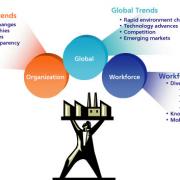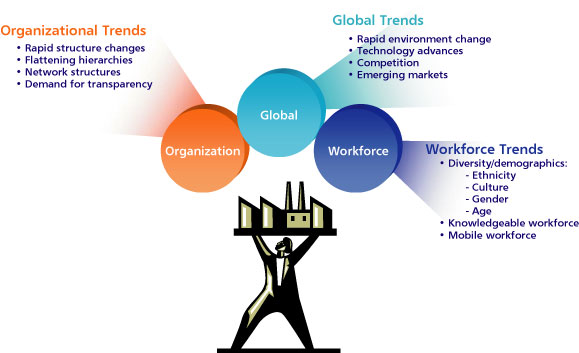
End of an EraDramatic changes in organization, technology, and outsourcing signal limited career potential for 21st-century IT professionals. |
A New DayHigh business expectations and a new demographic mixture signal a world of opportunity for 21st-century IT professionals. |
"Information and information technology have been (and will continue to be) drivers for a fundamental shift in business operating models. But will IT as a function be a relevant part of this? And if so, at what impact to the oft-maligned IT worker?"
-- Robert D. Scott, Guest Editor
Opening Statement
The recent global recession has demonstrated just how tightly integrated the world's economy has become. Organizations are now forced to closely examine every aspect of their business to address the unrelenting and accelerating forces of globalization, emerging technologies, and demographic change that are reshaping how business gets done.
It is clear that organizations are setting new expectations for their IT departments. Historically, the mission of IT was to reduce business and technology costs by optimizing existing IT assets and processes. While there is still demand for asset optimization and process efficiencies, organizations expect innovative breakthroughs from their IT departments in such areas as virtualization of work and leveraging the consumerization of technology. In many cases, the CIO is expected to lead these breakthroughs, both from a championing and execution point of view.
So information and information technology have been (and will continue to be) drivers for a fundamental shift in business operating models. But will IT as a function be a relevant part of this? And, if so, at what impact to the oft-maligned IT worker? Is there a 21st-century IT professional?
In my role at the University of Michigan's Ross School of Business, I am often asked by the computer science and engineering students about the future of meaningful careers in IT. The perfect-storm impact of global and organizational forces combined with the recent economic upheaval has students rightly worried:
-
Haven't all the key positions moved offshore?
-
Doesn't outsourcing make any IT position insecure?
-
Aren't most roles "old school" work, locked in a room programming? What's cool about that?
-
Does IT even matter now anyway?
Let's face it; today's students have every right to be concerned. They have been witness to a tsunami of change that has impacted every facet of their lives. The trends behind this change (see Figure 1) have also upset the confidence and psyche of those already in the IT workforce.

Figure 1 -- Trends that are shaping the future for IT workers.
Organizational trends are characterized by rapidly shifting internal organizational structures, networked structures with external suppliers and customers, and flattening hierarchies. In today's world, global political systems, infrastructures, and economies are now so tightly interconnected that companies, governments, and industries are forced to cooperate in novel ways. Failure to do so means losing on the innovation and cost-effectiveness battlefields. These changes are behind the push for outsourcing and offshoring. They also drive work demand for IT, as the function has to respond quickly to acquisitions and divestitures or other data-intensive organizational interventions. The downside of this has been the erosion of the historic employer-employee contract. The security expected by the Baby Boomer-generation IT worker has disappeared, swept away by repeated waves of downsizing.
Global trends include the continued and accelerating rate of technology change and the emergence of new markets that provide both marketplace competition and potential new sources of resources and partners. Emerging markets have become the new hotbeds of innovation. As a result, a new middle class of consumers has emerged, generating new consumer markets. More products and services are being consumed outside of their country of origin; globalization is driving a convergence of consumer tastes and preferences across regions and countries. At the same time, there is the opposite force of divergence pushing companies to adopt strategies, marketing plans, and production processes tailored to local domestic markets.
Workforce trends are the demographic shifts that change the makeup of the workforce. The Baby Boomers are giving way to the Millennials; employee ranks now have increasing ethnic and gender diversity; and the knowledge worker of today expects to be mobile, with telecommuting an increasingly routine way of doing business.
The IT professionals of today and tomorrow are center stage for all of these critical changes. But are they ready? More importantly, are IT organizations in general and CIOs in particular ready?
Much has been written about the role of the 21st-century CIO. In the face of these complex, interconnected trends, the CIO is responsible for ensuring operational excellence, aligning IT with the business, and leading initiatives that transform how the enterprise operates ... all while devoting more personal time to a new role as business strategist. CIOs are being judged by their ability to leverage information technology to drive business strategy and innovation for competitive advantage. However, it is equally important that the CIO lead the development of an IT staff with the skills and experience to deliver all of this.
In our first article, R Dhakshinamoorthy focuses on the new roles that IT will have to take on given the changes identified above. He points to a number of areas of technology expertise that 21st-century IT professionals can choose to specialize in -- a critical concern for young job seekers who worry that all the meaningful technical roles have moved offshore. He goes on to describe several skill areas that will be crucial in the future given technology trends such as cloud computing, heightened security requirements, and the growing need to improve usability for knowledge workers.
Charlie Bess and Claudio Bartolini hit the demographic shift head on by exploring the impact the Millennial generation is having on the workforce. They assert that there is a mismatch of expectations between the Millennials and the Boomer workforce they are replacing. This is actually a hotly debated point -- how really different are the Millennials in terms of work ethic, loyalty, and career expectations? Bess and Bartolini argue that they are different, and their article offers some useful suggestions for CIOs to consider in embracing this generation and harvesting the innovative energy they bring.
In our next article, Raja Bavani draws from his own life experience as an IT professional to illustrate that continual learning is a requirement for successful IT professionals. He reflects on the convergence of new IT technologies and the exponential growth in data as a result. This convergence necessitates that 21st-century IT professionals develop new competencies (knowledge) and skills (practice) critical for software development. Taking a page from Stephen Covey, Bavani frames these new skill areas into seven essential habits for highly effective IT professionals. He asserts that these habits are critical to the success of 21st-century IT workers given the ever faster rate of marketplace and IT evolution.
Gabriel Capmany, Jose Pedro Pagano, and Jorge V.A. Ronchese discuss the significance of recent changes for the IT department and the roles within the department. They believe that the IT department needs to focus on global optimization: defining needed work processes on an integrated scale that goes beyond traditional silos. This has major implications for what work gets done where and by whom. Based on this, they redefine the future IT team. Their article lists essential roles that will be required in a world where applications are based on cloud technologies, are developed offshore, or are based on integrated software platforms such as enterprise resource platforms. Higher expectations for business integration demand tighter integration with business partners as full team members throughout the development and startup phases of a project and beyond.
In our last article, Vijaykumar N focuses on a perennial career dilemma for every IT professional: do I go broad or deep? Is it better to develop a broad base of technical skills that are adaptable as technology and business evolve, or should a 21st-century IT professional work to develop a deep technical expertise in a critical area? If so, how should that area of specialization be chosen? When should one let go and move on because that area is no longer relevant? These are difficult career choices that confound individual workers and senior IT leaders alike.
There are no clear-cut answers to any of the questions raised by this month's articles. These are volatile and uncertain times, complicated by the fact that these are issues for and about people. Many corporations will invoke the value "People are our greatest asset." IT leaders, particularly the CIO, have a tremendous challenge in determining how this value is to be manifested in their organizations.
ABOUT THE AUTHOR
It is clear that organizations are setting new expectations for their IT departments. Historically, the mission of IT was to reduce business and technology costs by optimizing existing IT assets and processes. While there is still demand for asset optimization and process efficiencies, organizations expect innovative breakthroughs from their IT departments in such areas as virtualization of work and leveraging the consumerization of technology. In many cases, the CIO is expected to lead these breakthroughs, both from a championing and execution point of view. So information and information technology have been (and will continue to be) drivers for a fundamental shift in business operating models. But will IT as a function be a relevant part of this? And, if so, at what impact to the oft-maligned IT worker? Is there a 21st-century IT professional?







